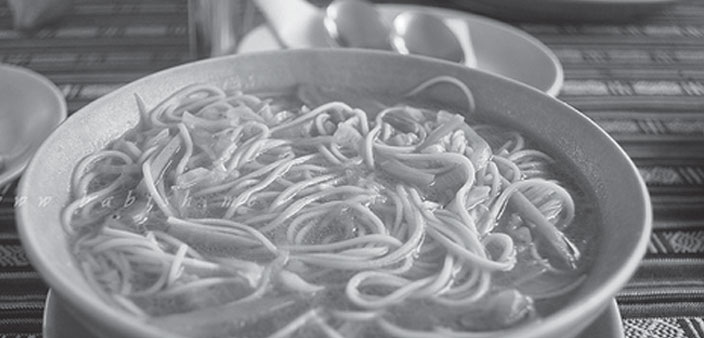Seven sisters and one brother – that is how the Northeast states comprising Assam, Meghalaya, Tripura, Mizoram, Arunachal Pradesh, Nagaland, Manipur and Sikkim are often referred to. Ethnically, culturally and linguistically different from the rest of India, it is no wonder that our cuisine and food habits are also markedly different from the regular Indian cuisine.
Momos, thupka, bland boiled stews are often (wrongly) regarded as the only representatives of Northeast cuisine. But thanks to the rich cultural diversity here, its traditions, and its abundance of natural and often rare vegetation, the cuisine is not limited to this. In fact, it is as varied as the various ethnic groups that inhabit this beautiful region.
We love our rice!
So what do we actually eat? Well, rice is our staple food and we have it for lunch and dinner. Even though the day begins early compared to the rest of the country, breakfast as such, is a modern concept for us. Among the Khasis of Meghalaya, a typical day would begin with a cup of tea and kpu which is made from rice flour. The rice is hand pounded in a big wooden mortar and pestle, and it is either steamed in banana leaves, hollow bamboo trunks or deep fried. Lunch is usually done by 10 a.m, tea by 3 p.m and dinner is had by 6 p.m!
Rice, meat or fish, vegetables and chutney are often what comprise lunch and dinner. Vegetables are often steamed or boiled or quickly flash fried to retain their crispness and colour. As Paul from Mizoram says, “We half boil the veggies – which is usually plucked fresh from our garden, or just drop them in boiling water for a few minutes and remove them before it is fully cooked. We don’t use any spices at all – turmeric, pepper, green chillies, onions, garlic and ginger is all we use to flavour our food.” No wonder then, that the Northeast cuisine has been described as bland, healthy, pungent, hot.
The meat is close behind
The people of the Northeast love their meat – be it pork, beef, chicken, duck, venison, silkworms, rabbit, or fish, and no meal is complete without a meat item. Pork obviously is the speciality and doh khlieh, a kind of dry meat salad made from a pig’s head is a specialty of the Khasis. Meat is often made into a stew with vegetables, or barbecued or smoked. Smoked meat is a lip-smacking delicacy in the Northeast. The meat – usually pork or beef – is cut into strips and smoked over many days over the kitchen fire. This preserves the meat which is then used in a variety of ways. It is either made into a gravy with potatoes, with bamboo shoot or yam leaves. Sometimes, this meat is pounded and a dry chutney is made out of it garnished with only onion, ginger and chillies. Fish is cured either by cutting them into strips, removing the bones and left to dry in the sun or by preserving them in salt. This is then made into a chutney with tomatoes, onions, and chillies.
Given the abundance of fresh leafy vegetables that grow here, we also consume a lot of vegetables. And it is no wonder then that Mizoram and Sikkim are the only two organic states in the country. The vegetables are either cultivated in kitchen gardens or plucked from the forests. Ferns, wild herbs, wild crocuses, pumpkin leaves, yam leaves, mustard leaves, banana flowers are some of the popular ones. These vegetables are either boiled, tossed into a salad or made into chutneys. Sometimes, radish, carrots, wild plums and wild pears are dried and preserved to be used either in cooking later or to be pickled.
So which food items are special among the Northeasterners? Fermented soyabeans is one. The fermented soyabeans are simmered on a slow flame for hours. Pieces of pork, ginger and chillies are added to it to make a lip-smacking blackish chutney called tungrymbai in Khasi, Akhuni for the Nagas and kinema in Sikkim. Relishing this winter specialty is often an acquired taste! Bamboo shoot – whether dried or fresh – is another specialty of this region and is added to meat for a distinct pungent taste. Sometimes rice or local specialties are cooked in hollow bamboo trunks which give it a smoked flavour. Roasted and ground sesame seeds – both black and white – are also used abundantly.
Since the cuisine is natural and preservative free, it goes without saying that no readymade spices are used. Fresh root ginger, garlic, black peppercorns, turmeric and chillies are always used fresh. Garam masala is an alien concept! The ginger and turmeric especially the Lakadong variety grown in abundance in the Jaintia Hills of Meghalaya are often exported because of its high curcumin content.
The region-wise specialties
Assamese cuisine is a wonderful amalgamation of the hills where fermentation and drying are favoured as well as of the plains where fish and fresh vegetables are used in abundance. Rice is a staple eaten with usually fish, duck or squab (young pigeon) and vegetables. The meat is either smoked, barbecued or boiled with either little or less amount of spices and oil, ginger, norosingho paat (curry leaves) and lemon juice. Fish is usually steamed or roasted in banana leaves (paatotdia). Hukuti is a special fish dish prepared from dried small fish (puthi maas) pounded with arum stem and dried and stored in bamboo tubes. This is roasted and along with green chillies, tomatoes, ginger and garlic, are pounded in a mortar and pestle and served as a chutney.
The cuisine of Meghalaya tends to lean towards rice. Jadoh – literally translated as rice meat is rice cooked with pig’s blood, the offal, ginger, turmeric and salt. Nowadays though, jadoh is cooked either with chicken stock or fish head stock. Another specialty of the Khasis is dai neiiong where the dal is cooked with roasted and ground black sesame seeds, and doh neiiong where any meat, usually pork, is cooked with black sesame seeds. Roasted and ground white sesame seeds are used to flavour cabbage or mooli salads. Soh baingong dieng or tree tomato – a vegetable that looks like a small brinjal but grows on trees and tastes like a tomato, is made into a fiery chutney with onions and chillies.
In Mizoram the food varies between different tribal communities. The most common among them is bai which is a stew made by boiling assorted vegetables, bamboo shoot, pork and spinach. Mizos love their fish sautéed in mustard oil, duck cooked with bamboo shoots and Misa Mach Poora which is shrimps grilled in banana leaves and delicately flavoured. Vawksa Rep or smoked pork is another popular side dish where pork chunks are cooked in open fire and flavoured with bamboo shoots and local herbs.
Due to its proximity to Nepal, the influence of Nepali cuisine can be seen in Sikkim cuisine. Momos, thupka – thin noodle soup with vegetables and meat is popular while Shapalay, a spicy, deep fried stuffed savoury similar to momos are foods that must be tried. Gyari a pork based curry style dish cooked with tender bamboo shoots is served with rice. Sikkim is also well known for chhurpi a traditional cheese. Gundruk made from mustard leaves, radish and cauliflower and Sinki made from radish tap root are traditional fermented vegetable products prepared during winter.
Naga cuisine also features an abundance of meat and fish which are primarily smoked, dried or fermented. Zuben, from Nagaland says that traditional Naga food consists of meats cooked with a lot of chillies, bamboo shoot and/or soyabeans. In fact the various Naga tribes – there are sixteen major tribes and an umpteen number of sub-tribes – each have their own distinct food habits. The Lotha tribe, for example, prefers cooking their pork with bamboo shoots, while the Sumi tribe has a strong preference for cooking with soyabeans. The Ao Nagas meanwhile love to make their pork with a preparation of dried yam leaves. The Nagas love their Raja mirchi or Bhoot Jholokia and generously flavour their meats and chutneys with this dynamite.
Like the other Northeastern states, Manipuri cuisine is light, tasty and fresh as they hardly use oil or spices either. Since the vegetables are grown in their own kitchen gardens, the food is seasonal. Eromba is a dish where the vegetables are boiled or steamed with red chillies, smoked fish and mashed together. Singzu is a chutney prepared from green vegetables, banana stems, banana flower, chick peas, local herbs and fermented fish called ngari and is relished all over the state.
A traditional meal is incomplete without an intoxicant and locally brewed rice beer is their poison of choice. In Arunachal, the local rice beer is called opo or apong, in Assam it is called laopani or kshaaz, chuak in Tripuri and ka kiad in Meghalaya, with each tribe having their own method of distillation. However tea drunk with or without milk is the preferred drink of choice today.
For any Northeasterner, however far from home they are, comfort food is always the traditional cuisine. Personally for me, a Khasi, who has lived most of her life in South India and Europe, my cooking is an amalgamation of different cuisines. In our home, though traditional Khasi food finds its way to the table very rarely and that too only on special occasions, the method and style of cooking leans towards less oil and spices. But for a person living in the Northeast, everyday food is the traditional food, and whenever we travel home, whether in my mom’s place or at my in-laws, this is what is usually served. One thing I do though, without fail, is to carry back with me turmeric, ginger, peppercorn, and organic vegetables from my mom’s garden – the vegetables in the city somehow lack the fresh and organic taste that we get back home!


